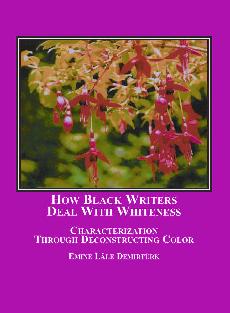This is our backup site. Click here to visit our main site at MellenPress.com
HOW BLACK WRITERS DEAL WITH WHITENESS:
Characterization Through Deconstructing Color

| Author: | Demirtürk, Emine Lâle | |
| Year: | 2008 | |
| Pages: | 248 | |
| ISBN: | 0-7734-5073-4 978-0-7734-5073-8 | |
| Price: | $179.95 | |
This study explores the social and discursive spaces and practices of whiteness in its social, cultural, political, ideological, and individual implications. The work examines the ways in which various African American novels deconstruct whiteness as an ideological appropriation of social space by delineating the relational status of the white identity.
Reviews
“Through [the author’s] rich and challenging essays she offers a living testimony to the continued global interest in the African American literary tradition and provides an outstanding example of the scholarship we have come to associate with this body of material that remains, as Dr. Du Bois claimed years ago, the gift African Americans had to give the world.” – Prof. Wilfred D. Samuels, University of Utah, Salt Lake City, Utah
“Demirtürk’s scholarship is nearly impeccable, and her writing, in the main, is clear, coherent, sharp, and lively. It offers readings of the texts that allow us to see how definitions of “whiteness”—legal, phenotypical, cultural, regional, national—vary considerably according to both the periods in which texts are composed and the places or people depicted.” - Dr. Darryl Dickson-Carr, Ph.D., Associate Professor of English, Southern Methodist University, Dallas, Texas
“Demirtürk’s text moves the reader through complex novels as a way of accessing habituated modes of whiteness. In short, her use of the African-American novel is not incidental to her project. Rather, it is through the African-American novel that theory regarding whiteness is concretized and given narrative existential flesh.” - George Yancy, Ph.D., Department of Philosophy, Duquesne University
“Demirtürk’s scholarship is nearly impeccable, and her writing, in the main, is clear, coherent, sharp, and lively. It offers readings of the texts that allow us to see how definitions of “whiteness”—legal, phenotypical, cultural, regional, national—vary considerably according to both the periods in which texts are composed and the places or people depicted.” - Dr. Darryl Dickson-Carr, Ph.D., Associate Professor of English, Southern Methodist University, Dallas, Texas
“Demirtürk’s text moves the reader through complex novels as a way of accessing habituated modes of whiteness. In short, her use of the African-American novel is not incidental to her project. Rather, it is through the African-American novel that theory regarding whiteness is concretized and given narrative existential flesh.” - George Yancy, Ph.D., Department of Philosophy, Duquesne University
Table of Contents
Foreword
Acknowledgements
Introduction: Theorizing Whiteness and Deconstructing Normative Spaces
Part I: Configurations of the White Mind and the Crisis of Whiteness
1. Mapping the Terrain of Whiteness: Richard Wright’s Savage Holiday
Part II: Historical Construction of Colonial Whiteness
2. Reading the Contours of Dynamic Whiteness in African American Women’s Neo-Slave Narratives
Part III: Corporeal Whiteness and Strategic Identifications
3. Passing for White and the Politics of Location: Negotiating the Boundaries of Whiteness
Part IV: Positing the Body in the Discourse of Whiteness: Shifting and Concealed Identities
4. Dismantling the Discourse of Desire for Whiteness in Toni Morrison’s The Bluest Eye
5. Postcolonial Reflections on the Discourse of Whiteness: Paule Marshall’s The Chosen Place, The Timeless People
Part V: Whiteness and the City: Social and Symbolic Urban Spaces
6. Racialized Spatial Zones in the Metropolitan City: Louise Meriwether’s Daddy Was a Number Runner
7. Alternative Conceptions of (Post)modern Urban Whiteness: Resisting and Revisioning the White City in Colson Whitehead’s The Intuitionist
Bibliography
Index
Acknowledgements
Introduction: Theorizing Whiteness and Deconstructing Normative Spaces
Part I: Configurations of the White Mind and the Crisis of Whiteness
1. Mapping the Terrain of Whiteness: Richard Wright’s Savage Holiday
Part II: Historical Construction of Colonial Whiteness
2. Reading the Contours of Dynamic Whiteness in African American Women’s Neo-Slave Narratives
Part III: Corporeal Whiteness and Strategic Identifications
3. Passing for White and the Politics of Location: Negotiating the Boundaries of Whiteness
Part IV: Positing the Body in the Discourse of Whiteness: Shifting and Concealed Identities
4. Dismantling the Discourse of Desire for Whiteness in Toni Morrison’s The Bluest Eye
5. Postcolonial Reflections on the Discourse of Whiteness: Paule Marshall’s The Chosen Place, The Timeless People
Part V: Whiteness and the City: Social and Symbolic Urban Spaces
6. Racialized Spatial Zones in the Metropolitan City: Louise Meriwether’s Daddy Was a Number Runner
7. Alternative Conceptions of (Post)modern Urban Whiteness: Resisting and Revisioning the White City in Colson Whitehead’s The Intuitionist
Bibliography
Index
